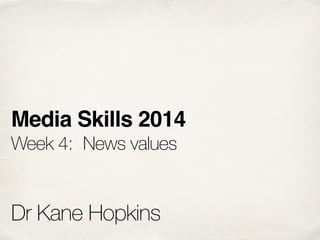Media Skills 2014: Week 4
- 1. Media Skills 2014! Week 4: News values ! ! Dr Kane Hopkins
- 2. What is News? News stops people in their tracks, it is arresting, happening and action. It is local, aïŽects peopleâs lives, shocks, informs, entertains, saddens, angers, surprises and feeds peopleâs curiosityâĶ if a dog bites a man it may not rate a mention but a man biting a dog is national news. Hudson (1994)
- 3. Newsworthiness âĒ Every day, millions of events occur throughout the worldâĶ only some of them become ânewsâ âĒ To be selected as news, an event or issue must be judged ânewsworthyâ by a journalist, and enter into the news cycle âĒ What makes an event or issue ânewsworthyâ? A journalist has an instinct or ânoseâ for news; attempts to codify this have led to the identiïŽcation of ânews valuesâ (or factors driving the selection and presentation of news)
- 4. News Values Professional codes used in the selection, construction and presentation of news stories in corporately produced mainstream press and broadcasting OâSullivan (1983, p. 153)
- 5. News Values âĒ News stories usually include a range of criteria or ânews valuesâ (Johnston, 2007, p.45) âĒ When seeking publicity, itâs important you share newsworkersâ understandings of what is and what is not news â allowing you to be proactive and relevant (but note there are still no guarantees of coverage!) âĒ Remember the commercial imperative that drives news, and that the media have no obligation to report about you or your organisation
- 6. News Values âĒ Journalists acquire their news sense through learning on the job. They learn that there is an unwritten kind of news âstyleâ of the publication or program they work for. Thus, they need to ïŽt into this style. âĒ Reporters develop a sense of their own organisationâs market pitch, competitors, and audience.
- 7. News Values âĒ News values are an informal code. Nowhere is there a manual for newsworthiness - Partly because it is unique to each publication - Partly because the ârulesâ are not supposed to exist âĒ News is supposed to be reported on public interest meritâ much of it is, itâs the deïŽning of âpublic interestâ where it gets tricky
- 8. NEGATIVITY Is the news bad or undesirable?
- 9. TIMELINESS Is the news new?
- 10. CONFLICT Is there any controversy?
- 11. PROXIMITY How close to home is the story?
- 12. ELITE PEOPLE Do we already know the person?
- 13. ELITE NATIONS Is the country one that is familiar?
- 14. PROMINENCE Are the people involved famous?
- 15. HUMAN INTEREST Does the story play on our emotions?
- 16. SIMPLIFICATION Is the story unambiguous?
- 17. Impact of News Values âĒ The institutional nature of news and newsgathering means stories about the economy, government/politics, industry, foreign and domestic aïŽairs (especially those involving conïŽict, human interest, disasters, sport) will be prioritised âĒ Within these above arenas, personalisation, conïŽict, violence, reference to elite people and nations, and negativity will be prioritised (and often will be emphasised in presentation).
- 18. Your ability to understand the media in commercial terms and help them win the ratings and circulations battles with your news is crucial to gaining publicity Hudson (1994)
- 19. Tips + Tactics (1) âĒ Monitor the media, taking notes of which outlets and sections (e.g. arts, property) cover similar organisations and topics (or your competitors!); capitalise on the current news agenda too âĒ Keep records of news coverage gained âĒ Identify opportunities and train/prepare relevant staïŽ for these âĒ Cover all potential angles to maximise opportunities and limit damaging situations but donât alter facts, mislead or exaggerate details.
- 20. Tips + Tactics (2) âĒ Be aware of what diïŽerent formats exist within diïŽerent media of television, radio, internet, magazines âĶbut alsoâĶ âĒ Think creatively about objectives rather than always getting caught up with content âĒ Donât alienate media with mediocre ideas; save your approaches for genuine solid oïŽerings and you will get a good reputation as someone to listen to
- 21. Tips + Tactics (3) âĒ News does not always take the form of a straight report; more publicity can sometimes be gained by adapting news to diïŽerent styles of presentation âĒ Donât forget the light hearted or quirky news opportunities âĒ Check Hudson (pages 22-24) for numerous ideas for news opportunities, from new equipment to awards to community assistance projects and research âĒ Or consider creating news through making predictions, oïŽering analysis, undertaking polls, etc. (pp.27-30)





















